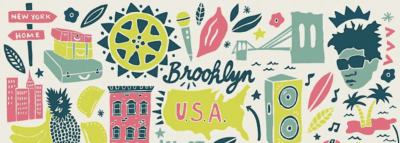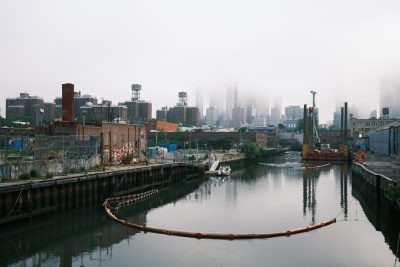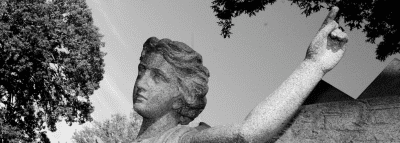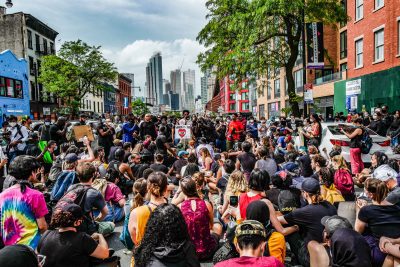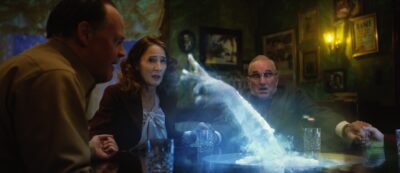Illustration by Jessica Ulman
A fleeting glimpse at the long-forgotten Brooklyn Bridge eagles
Remembering a flock of elaborate subway plaques, installed in 1904, that have been sealed off from public for six decades
This past summer, riding a wave of encouraging news about the restoration of 24/7 service and a deferred fare increase, the Metropolitan Transportation Authority unveiled three new artwork and photography installations for the subway. The highlight was a piece titled Handcrafted Reality, a 52-screen digital display at the Fulton Complex that, according to the press office, boasts “two chihuahuas dressed as Bambi roaming around a virtual landscape.”
Sure, the subway’s still late, dirty and expensive, but you have to salute the MTA on this one. Amid a yawning budget deficit of $16 billion and anemic ridership levels, the brass was still trying to pretty things up below ground.
It was a noble effort, if also paradoxical one. That’s because the subway happens to have a stunning bit of décor on its hands already—of particular relevance to Brooklyn—and subway riders aren’t allowed to see them.
I’m talking about the Brooklyn Bridge eagles.
Never heard of them? That’s not a surprise. Perched on the walls of a pair of abandoned subway platforms at the Brooklyn Bridge station on the 4, 5 and 6, these rare birds have been sealed off from public view—entombed, literally, behind brick walls—for six decades now. I know this not just because I’ve read my history, but because I’m among a relative few to have laid eyes on the birds. If not exactly legally. But I’ll get to that part.
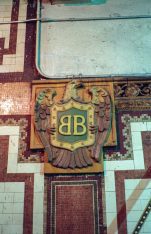
Photo by Robert Klara
City beautiful
Today’s subway is a sprawling labyrinth of 472 stations along 665 miles of track. But back in 1904, it was just a single line starting at City Hall (the fabled station of Guastavino-tiled vaults abandoned since 1945) and meandering uptown. London, Budapest, Paris, Berlin, Boston—all had opened subways years before. For once, New York was late to the game. To be of any consequence, then, this city’s system would need to set a new standard.
And it did. Thanks to the vision of chief engineer William Barclay Parsons, New York’s subway would have both local and express trains—a first for the underground. What’s more, its stations would be elegant. Having toured Europe’s subways, Parsons was dismayed to find them lacking in aesthetic appeal. “No attempt was made to give them a pleasing appearance,” he complained in 1894. And so, by the time the architectural firm of Heins & LaFarge got to work on the station interiors, the contract spelled things out.
“The railway and its equipment as contemplated by the contract constitute a great public work,” the document read. “All parts of the structure where exposed to public sight shall therefore be designed, constructed, and maintained with a view to the beauty of their appearance.”
“The City Beautiful Movement was starting,” observes Michael Padwee, a Brookyn-based artist and tile historian. Neoclassical décor, he continued, “was needed for the people who were going to use the subways. Why just go into a hole in the ground and see nothing? This way, they were exposed to something artistic.”
Heins & LaFarge dressed the stations of the Interborough Rapid Transit Company in neoclassical finery—roman brick wainscoting, marble coping, cornices and mosaic name panels. But the flashiest jewelry the stations would wear took the form of oversized plaques of glazed terracotta.
Which brings us to the eagles.
Boston-based Grueby Faience Company received the commission to create elaborate plaques of faience, a double-fired terracotta with a jewel-like, lustrous glaze. Grueby would decorate a host of stations, but Brooklyn Bridge would be special. Much like the Union Square and 33rd Street stations, Brooklyn Bridge would boast bald eagles high on its walls, clutching plaques in their talons. But unlike any other station, these eagles displayed the initials “BB,” the first “B” reversed to create a monogram.
“The monogram itself was the unique thing about Brooklyn Bridge station,” says author Philip Copp. “It makes it a royal structure. Monograms are the stuff of the ruling class. It seems ridiculous to adorn a subway station with a monogram. But this is the first subway, so of course you’re going to make it a grand affair.”
The BB monogram was a bit of an impish touch amid an otherwise serious civic undertaking, and I’m not the only one to have felt a kind of wink from Heins & LaFarge over it. “I’ve experienced the same ‘playful’ reaction to the double Bs [as you did],” the historian Stan Fischler told me. “There’s a song, Little Things Mean a Lot. The whimsical arrangement, in its own curious way, did and does mean a lot.”
It’s something of a mystery, however, why Heins & LaFarge the designers chose eagles for the Brooklyn Bridge stop. After all, the decorative plaques at other stations usually commemorated something of local significance: the beavers at Astor Place to signify the Astor family’s fur trade, for example, or the ship Santa Maria rendered in faience at Columbus Circle. It would have been imminently more logical to have adorned the Brooklyn Bridge station with a rendering of its namesake—the great suspension bridge that joined New York to Brooklyn in 1883.
So why didn’t they? Historian John Tauranac has a theory. When the subway was on the drawing board, the ink had barely dried on the 1898 consolidation of New York’s boroughs into one city. Tauranac ventures that the Brooklyn Bridge eagles symbolized a kind of manifest destiny: The great cities of New York and Brooklyn uniting amid a surfeit of national pride.
“When you think of the notion that the United States was going to extend from the Atlantic to the Pacific—and with the advent of railroads it became a feasible thing to travel from one side of the continent to the other—I think that using the eagle at the Brooklyn Bridge station was symbolic of that kind of unification,” he says.
For the birds
For all these birds’ pomp and portent, however, they were doomed nearly from the start.
To increase the efficient movement of riders, Parsons had furnished several express stations with dedicated side platforms for local trains, which were only five cars long in 1904. But when surging ridership forced the Interborough to run longer trains in 1911, the cost of expanding the local platforms was too great, so the company simply closed them.
Unfortunately, the local platforms happened to be the Brooklyn Bridge eagles’ only roost.
It was bad enough that the eagles were left in the shadows, but worse was in store. In 1959, the Transit Authority commenced a $6 million effort to renovate and modernize the Brooklyn Bridge station, and bricked up the old local platforms for good. Ever since, the Brooklyn Bridge eagles have been shut off from the public’s view.
They’d have been shut off from my view, as well, were it not for a workman named Mike.
As you read this, the Brooklyn Bridge eagles are still down on those abandoned platforms, nesting in the dark. I remember them as clearly as yesterday, though it was a bit before yesterday that my chance came to visit them.
One afternoon around 1993, I got off the 4 train at Brooklyn Bridge to do some research at the Municipal Archives. Up on the station’s mezzanine, I noticed a pair of steel doors propped open to allow air inside for a man working down on the old downtown local platform. I’d read enough subway history to know what I was looking at, and managed to talk the suspicious Mike into letting me inside. The eagles were all still in place, lifting their beaks into the murk. I snapped away with my 35mm camera for two minutes, stunned by my good luck.
If the downtown eagles were still there, I figured the uptown ones must be, too. As best I could determine, the steps leading to their platform would lie behind a wall on the east mezzanine. But getting down there would require more planning, more deceit and more balls. Fortunately, a 24-year-old me had those things.
On the afternoon I found the access door—unlocked—I slipped inside a pitch-black vault of heat and filth. The station porters had used the abandoned platform partly for storage, but mostly as a place to throw garbage. Picking my way down the steps, I watched for rats. I pondered asbestos. I imagined what would happen if someone locked that door behind me. I was in and out in 90 seconds. Only later, after the film came back from the developer, did I fully appreciate what I’d seen: A shameful wreck of a once-grand subway station whose neglect had somehow also worked to preserve it. The IRT’s original two-tone paint remained on the columns. Ruby red mosaics glinted in my camera flash. A magnificent wrought-iron rolling gate still hung from its tracks.
Mostly, though, I remember the eagles. Leaking water had damaged the terracotta, but they were still there, high on the opalescent tiled walls, waiting for trains that would never come, and for passengers who’d never ride them.
But at least we still got chihuahuas dressed as Bambi.
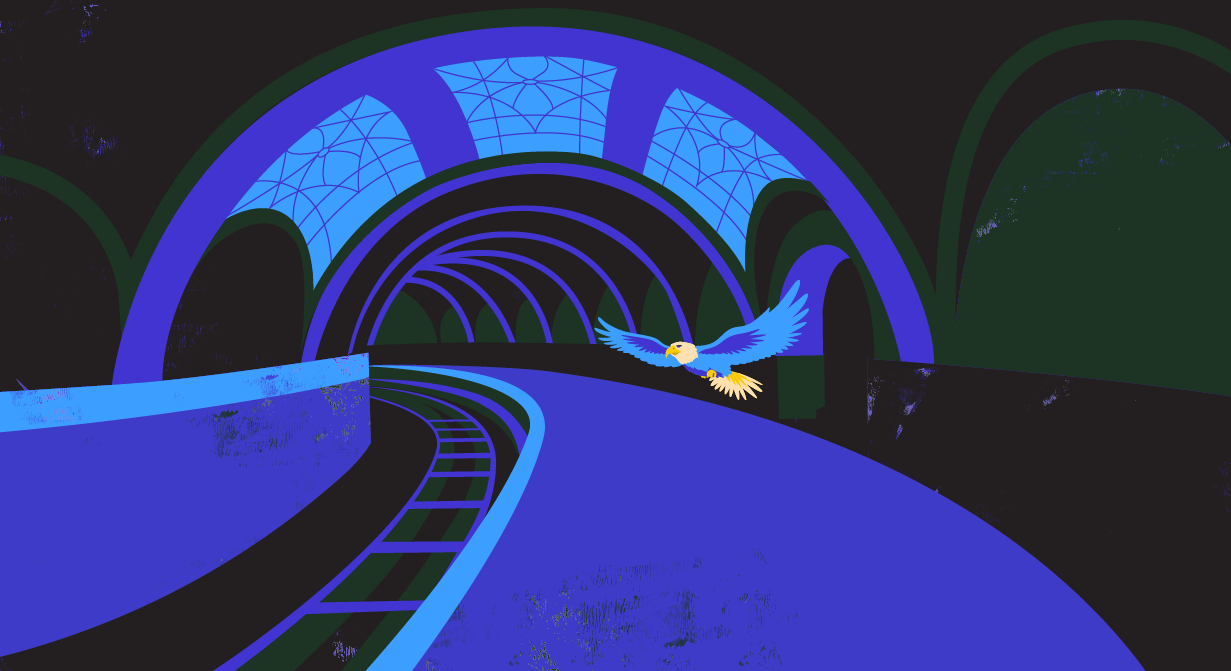

Illustration by Jessica Ulman
You might also like 

















